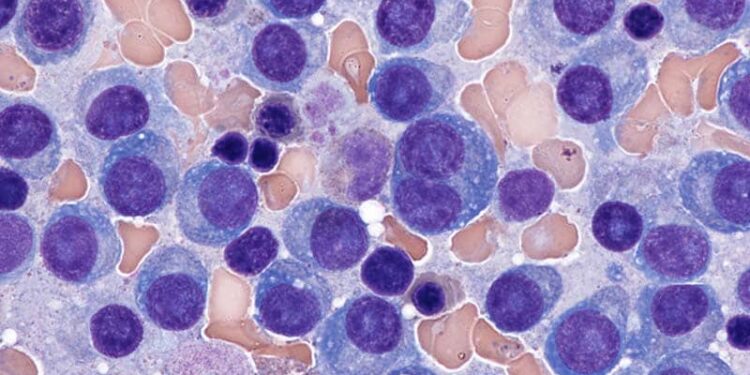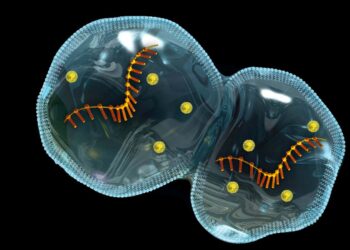When Mateo Mejia Saldarriaga, MD, first started seeing multiple myeloma (MM) patients as a medical student in his native Colombia 10 years ago, he was intrigued by the multifaceted nature of this blood cancer — and determined to join the effort to find more effective treatments.

“Some patients have very aggressive myelomas, and others are completely asymptomatic for 20 or 30 years and never need treatment. There’s a very big spectrum, so the clinical management is quite diverse,” said Saldarriaga, who is now on staff as a hematologist-oncologist at Weill Cornell Medicine and NewYork-Presbyterian, New York City. “When you couple that with the opportunity to study the basic biology behind that, it’s a really interesting intersection.”
By the time he completed his training with a hematology and oncology fellowship at Weill Cornell in 2023, two CAR T-cell therapies were on the market to treat MM, offering prolonged or complete remissions in large subsets of patients. Now a third CAR T for MM is in clinical trials. Saldarriaga is excited to be working in translational research and treating patients at a time when research aimed at improving treatment outcomes in MM is bearing fruit.
“This disease had poor outcomes, and that has really changed with the explosion of myeloma therapies in the last 10-15 years,” said Saldarriaga. “It’s a very privileged position to be working in myeloma right now.”
A Quest to Improve Outcomes
Saldarriaga sees MM patients 3 days a week, with the rest of his time spent taking part in research. He also helps manage the inpatient service for Weill Cornell’s cell therapy team, which exposes him to patients undergoing cutting-edge treatments for a wide variety of cancers.
Much of his research is focused on improving the efficacy and safety of CAR T-cell treatments in MM. The two CAR T-cell therapies approved by the US Food and Drug Administration for MM — idecabtagene vicleucel and ciltacabtagene autoleucel — target B-cell maturation antigen (BCMA) and have high response rates in patients with late-line MM that has progressed. But they can cause side effects, including neurotoxicity. “Once patients progress, they’re almost immediately a candidate for CAR T, but our main concern is safety,” he said.
Saldarriaga and his colleagues are designing a clinical trial investigating whether administering low doses of radiation to patients undergoing CAR T-cell treatments can enhance the cancer-killing effect of the cells in MM. They are also investigating the potential of steroids in helping lessen the risk for neurotoxicity.
Additionally, Saldarriaga is pursuing research in extramedullary disease (EMD), a condition associated with poor outcomes in which myeloma cells grow outside of the bone marrow. His research centers around studying the genomic characteristics of MM patients with EMD, including the heterogeneity of cancer cells inside and outside the bone marrow, as well as the characteristics of the tumor microenvironment. His ultimate goal is to gain insights that will help enhance treatment strategies for patients with EMD. That includes determining whether low-dose radiation will enhance the ability of CAR T cells to migrate out of the bone marrow and attack extramedullary tumors.
“He’s a dedicated clinician who sees science as a tool for improving the lives of patients,” said Ruben Niesvizky, MD, oncologist and director of the Multiple Myeloma Center at Weill Cornell Medicine and NewYork-Presbyterian. “Patients with high-risk extramedullary disease don’t respond well to treatment. Therefore, we have to develop out-of-the-box approaches to understanding the biology of these myelomas and the mechanisms behind the resistance to therapy. That is his primary interest.”
From Colombia to New York
Saldarriaga grew up in Medellín, Colombia, and obtained his medical degree at Universidad CES in his hometown. He thought he wanted to be a cardiologist, but that quickly changed when he started doing rounds with one of his mentors, who was an oncologist. “When I saw patients with myeloma, I was fascinated,” Saldarriaga said.
After earning his medical degree, he completed a residency in internal medicine and served as chief resident at the Jacobi Medical Center, Albert Einstein College of Medicine, New York City. He then went on to the fellowship at Weill Cornell, during which he further developed his clinical skills working with Niesvizky.
Saldarriaga said his Latino heritage helps him foster long-term relationships with many patients, particularly those who only speak Spanish.
“I believe a huge part of myeloma care is the relationship with your doctor, especially since our patients live much longer,” he said. “Even if they come with their relatives that speak English and are able to translate, I can see in their faces the relief when I am able to communicate directly with them. Additionally, being Latino helps, as most of our Spanish-speaking community is also Latino. This helps to connect not only through language but through a shared culture.”
Making a Mark in Research
As a researcher, Saldarriaga is already building a solid reputation in the MM community. In 2023, an EMD study he co-authored, for example, was presented in a poster session at the 2023 American Society of Clinical Oncology annual meeting. Using CoMMpass, a large international registry of newly diagnosed MM, Saldarriaga and his colleagues examined genomic and clinical data from more than 1000 patients and demonstrated that median overall and progression-free survival were shorter for those with EMD. They also found specific genetic signatures in the EMD samples, some of which are associated with poor outcomes.
“What we saw is that for patients with EMD, the genomic landscape is very different. They have higher rates of high-risk genetic alterations,” Saldarriaga said. “The next step is to look at our cohort of patients at Weill Cornell.”
Saldarriaga and his team are genetically sequencing MM patients at Weill Cornell, with the goal of comparing cancer cells found in the bone marrow with those that are outside of it. “We want to compare differences within the same patient,” Saldarriaga explained. “Some of the preliminary data has shown that even in the same patient, the extramedullary disease is much more genetically complex and has much higher mutational burden” than tumor cells within the bone marrow do, he said.
Saldarriaga has also become a leading voice on the future of CAR T-cell treatments in MM. At the Lymphoma, Leukemia & Myeloma Congress held in Miami in February, he spoke about the promise of the third MM CAR T-cell treatment currently in development, ie, anitocabtagene autoleucel (anito-cel). Like the two already approved such therapies, it also targets BCMA.
“The question was, do we need a third one given that those two products are quite effective?” Saldarriaga said. He told the conference attendees that his optimism about having a third choice revolves mainly around the potential to lessen the risk for neurotoxicities. With the currently used CAR Ts, between 10% and 15% of patients experience brain side effects, which can include Parkinsonian symptoms, he said.
“What is most interesting about anito-cel so far, is that in over 130 patients, they haven’t seen neurotoxicity, and the efficacy seems quite promising,” he noted.
Giving Back
In all of his work in the lab and clinic, Saldarriaga’s Colombian heritage and training are never far from his mind. “I’m always thinking about how I can pay it back and make sure that what I’m doing here has some impact in Colombia,” he said. So, when he was offered a chance to collaborate with oncologists in Colombia on a study of a novel digital education program for patients with MM, he jumped at the chance.
The study, published in 2024 in the Journal of Cancer Education, enrolled 32 patients with newly diagnosed MM. They were split into two groups: Patients in one group received conventional education about their disease and treatment, while the others were given access to an interactive virtual platform that used video, texts, audio, and other multimedia to address a wide range of topics, including therapeutic options in MM, pain management strategies, the importance of adherence to maintenance treatments, and tips for preventing relapses and complications.
The authors reported that patients who participated in the digital education program had higher treatment adherence rates and better reported quality of life. “The hypothesis was that multiple myeloma is hard for patients to understand [and] that by increasing their understanding of the disease and how to manage it, they will become more empowered. I think this reinforces the importance of education in myeloma,” Saldarriaga said.
Niesvizky said Saldarriaga’s ability to speak Spanish is helping Weill Cornell expand its research collaborations in Spain and Latin America. “Establishing relationships with highly talented physicians in Spanish-speaking countries will open the door to putting together [patient] databases and treatment algorithms that could lead to more robust research.”
Future Research Ambitions
As for his future research endeavors, Saldarriaga plans to continue to search for therapies that will improve the outlook for MM patients. That will include finding new ways to perfect CAR T-cell treatments. “There are still many ways we can refine CAR T. I think in the future, we’re going to have new targets that we use that will be safer [and] more effective and [will] hopefully cure patients.”
Improving access to cutting-edge MM treatments worldwide is another priority for Saldarriaga — and a goal that was motivated by his work in Colombia, where resources for patients were often strained, he said. “Really understanding that you have to prioritize not only what’s effective for patients but also what’s practical and feasible was very important,” he said of his training there.
Advanced therapies such as bispecific antibodies and CAR T-cell therapies are still largely inaccessible to MM patients in Columbia, he added. “I kept reading about all these amazing medications, but I saw many patients who were not able to get them. Patients don’t benefit from journal articles. They benefit from getting medications that work. So, I think there’s a lot of work to be done in not only making these treatments more effective but also more accessible.”
Treating patients will continue to inspire his work in the lab, Saldarriaga said. “I am a researcher, but first, I am a clinician. All of my research projects have started from clinical observations. I think that’s invaluable.”
Saldarriaga disclosed no relevant financial relationships. Niesvizky reported ties with Amgen, Bristol Meyers Squibb, Celgene, Janssen, Karyopharm Therapeutics, and Millennium Pharmaceuticals.
Source link : https://www.medscape.com/viewarticle/myeloma-specialist-seeks-improved-patient-outcomes-explosion-2025a100085y?src=rss
Author :
Publish date : 2025-04-04 12:56:00
Copyright for syndicated content belongs to the linked Source.














